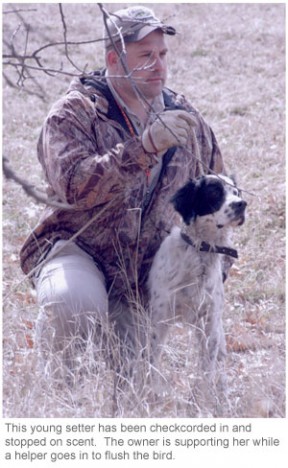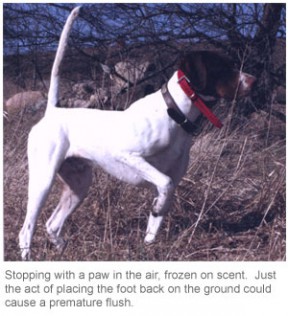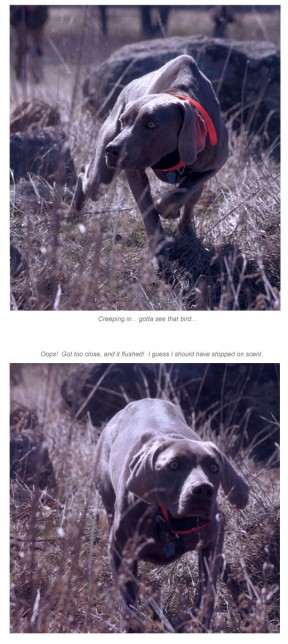



Stopping On Scent



What’s really amazing, however, is that knowing what we do know about a dog’s scenting ability, many people still don’t trust it to find birds. Humans project their limits onto their dogs and want them to get in close enough to the bird that they could find it without the dog, rather than trusting the dog to use its wondrous nose and stop on scent. Kind of defeats the purpose of having a dog, doesn’t it?
A good bird dog should stop on scent, and that means first scent – not waiting until it gets stronger. The closer the dog gets to the bird, the likelier it is the bird will flush, and that cost us the shot in most cases. Bumping or spooking a bird and making it run is not conducive to shooting opportunities. Anything a dog does that costs us a shot, the dog should not have done.
There are a lot of variables that can change the way a dog gins and uses scent. Hot, dry conditions make scenting tougher; cool and damp are better. Strong, gusty winds can play havoc with scent, and adding hilly terrain can make it even more difficult due to the wind shifts. A light, steady breeze makes conditions better. These are just a few of the factors that affect the way a dog locates birds by scent.
We want the dog to be totally immobile, because any movement runs the risk of telling the bird where the predator is. That stiff tail and high head aren’t just for good looks and style; they have a purpose. The tail held rigidly is less likely to give away the dog’s location to the bird, and the high head picks up scent if the bird should move or the wind shifts. Stopping on scent means complete and total immobility. No head movements, no whining or barking, no flagging of the tail.
What if a dog loses scent while on point? It happens often. The wind may shift and cause the scent ot change direction, but many times if the dog remains in place, the wind will come back around again the dog will pick it back up. If the bird hasn’t moved but the dog relocates because it lost scent, that bird is more likely to flush.
What about a bird that moves or runs? A dog will act differently if the bird is on the move. You’ll see the dog’s head and/or eyes follow the bird as it moves, and then it’s your call as to when to the dog should relocate. This is where knowing your dog’s body language is invaluable. In either case, a dog will often start slowly flagging its tail when it loses scent.
There is one important exception to stopping on scent, however, and that in honoring or backing. Scent is not required for a dog to honor another dog’s point. This is visual alone, although it is not uncommon for the backing dog to pick up scent after it has stopped. When a dog sees another dog on point, it must stop immediately as soon as it sees the other dog. The dog holding point has the location of bird scent, the backing dog does not, and so the backing dog has to follow the lead of the pointing dog so it won’t risk spooking and bumping the bird.
To train a dog to stop at initial scent means that, first and foremost, the dog has to understand birds and bird smells. This means introducing the dog to plenty of birds and building prey-chase drive. Sure, the visual of a bird running or flying is great for getting a dog excited, but the dog also learns to use its nose to find more of these fun, feathered, flying things. And that’s what we’re after. We want an excited dog that really wants to find birds, and since dogs glean information from their noses, that’s how they learn to locate prey.
We like to give our young puppies plenty of birds to play with, teaching them about bird scent and how much fun birds are. Turning a littler of pups loose with a life quail or two can really build their desire and give them an exciting introduction to bird scent.
How do we teach our dogs to stop on scent? By first teaching them to stand still without any bird scent present. This is learned by training for “whoa” with the whoa-post and training table. If a dog can’t stand still without distractions, expecting it to stand when there are birds around is not likely to happen.
Checkcording a dog into birds is a great way to teach stopping on scent. You’ve got control of the dog and can give it the best possible chance to get into the scent cone. Always checkcord a dog into a bird from the downwind side, working back and forth across the wind. This gives the dog maximum change to gain scent. Remember: A dog has to inhale to take in scent, so zigzagging across the wind fives the dog multiple chances to inhale within the scent cone. Also remember that scent rises and spread as it dissipates, so try to keep the dog’s head up.
Many young and inexperienced dogs won’t want to use their noses – they want to go in and see the bird. Don’t allow it, or you’ll create a hard habit to break. If you’ve already introduced them to birds, checkcording into scent will be more successful. Also, don’t talk to them. Let them work out the scent on their own. Talking is just an additional distraction they don’t need. Let them keep their focus on the birds.
Watch your dog carefully for signs that it has scent. A dog that gets birdy will act more excited. The tail may wag rapidly, the ears may perk up, and the dog will want to go toward the source of that wonderful smell. As you’re checkcording your dog, watch closely for these signs so you can gently stop the dog when it acts birdy. When you stop the dog, your goal should be to do it without distracting it from the scent and the bird. Be sure you remember where you planted the bird, and pay attention to the wind direction so you can work it across the downwind side. Your goal is to stop the dog when it begins to act birdy. Do not allow the dog to creep in closer, and don’t be tempted to guide the dog in closer. Remember, the dog is the one with nose; don’t teach your dog to go in any closer than it needs to in order to catch scent.
Dogs that try to point too close of slight end up flushing most of their birds prematurely, and that cost us shots. It’s got to be a partnership, wit each doing their job. The dog’s job is to point and hold the birds; our job is to shoot them.